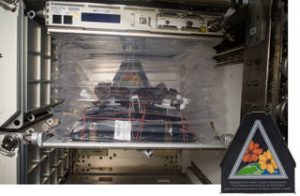
For a mid-afternoon snack, NASA astronaut Shane Kimbrough cut some of the “Outredgeous” Red Romaine lettuce leaves he nurtured during the past month aboard the International Space Station as part of a gardening harvest technique termed “cut-and-come-again.”
Kimbrough initiated the most recent round of the Veggie experiment on Oct. 25, and for the first time in space, all six lettuce plants are growing simultaneously. Kimbrough has taken on the part-time role of on-orbit gardener, working virtually autonomously to cultivate the crops, although gardeners on the ground at Kennedy Space Center provided help in the beginning.
“During their first week of life, the small seedlings were getting too much water,” said Veggie Project Manager Nicole Dufour. “This put the plants’ growth a bit behind schedule, but they recovered nicely after we instructed Kimbrough to use a fan to dry up some of the moisture.”
Cut-and-come-again is a repetitive harvest technique in which a selection of leaves can be harvested for a bit of fresh lettuce and possibly science samples. The remaining leaves and the core of the plant are left intact and will continue to grow and produce more leaves for subsequent harvests approximately every 10 days. The goal is to increase the on-orbit crop yield, as well as allow for more opportunities to supplement astronaut diets with fresh, nutritious food.
“Testing this method on-orbit, after using it on the ground, is very exciting for us,” said Dufour. “A repetitive harvest allows us to provide more food for both the crew and for science, so it’s a win-win. We are looking forward to hearing how Shane enjoys his first harvest!”
Today’s harvest will be solely for crew consumption, and the plan is to have four harvests in total, with the final harvest targeted for the first of the new year. The yields from these harvests will be split between samples for science return and crew consumption.

This experiment also is an important demonstration of how NASA applies science across disciplines — in this case Space Biology to grow a healthy crop and Human Research to ensure astronauts remain healthy — to enable human space exploration. NASA’s Space Life and Physical Sciences Research and Applications division integrates and funds such research.
